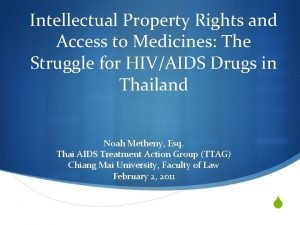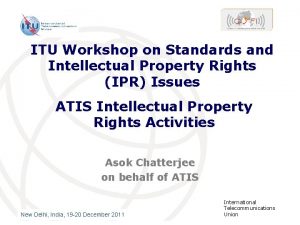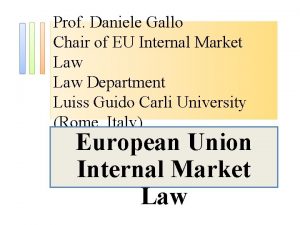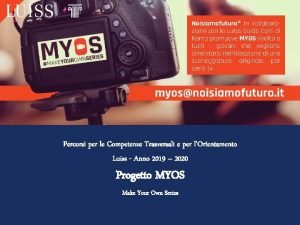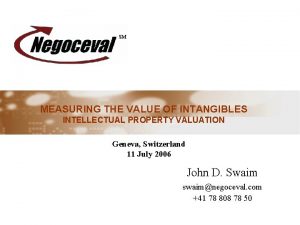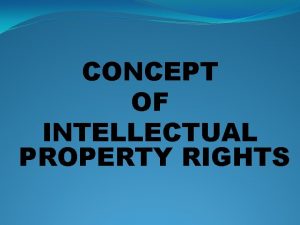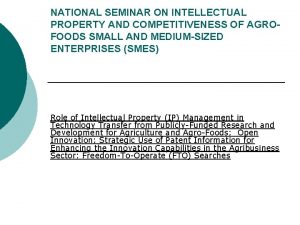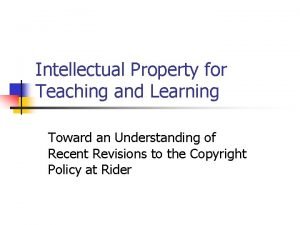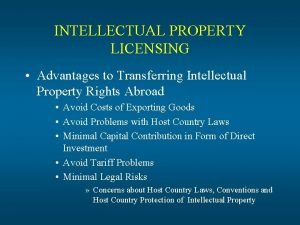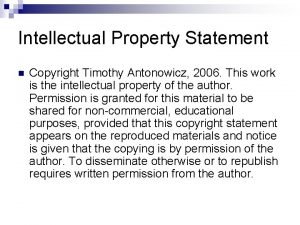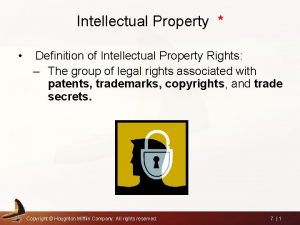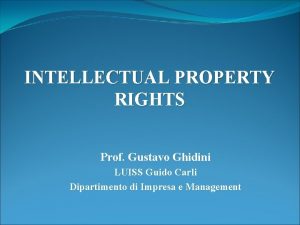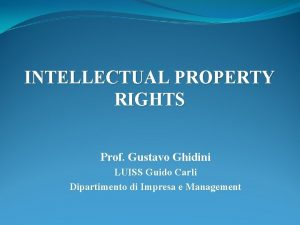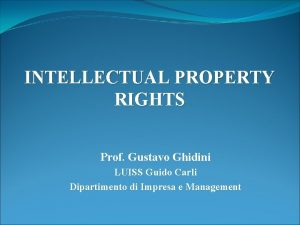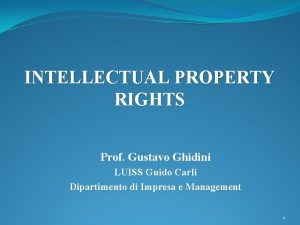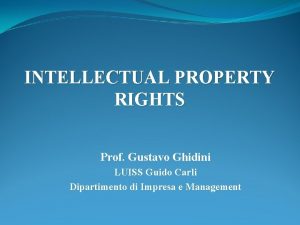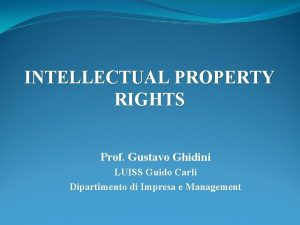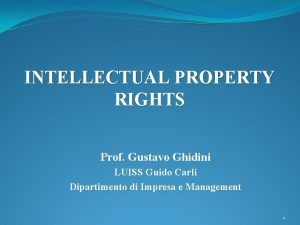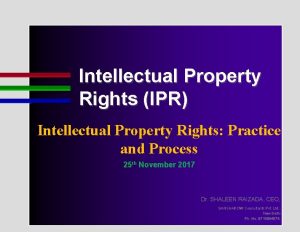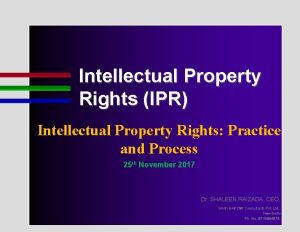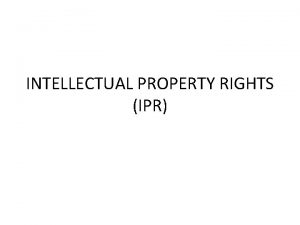INTELLECTUAL PROPERTY RIGHTS Prof Gustavo Ghidini LUISS Guido



















- Slides: 19

INTELLECTUAL PROPERTY RIGHTS Prof. Gustavo Ghidini LUISS Guido Carli Dipartimento di Impresa e Management 1

“Intellectual Property Rights and Competition Law” Lesson 18 – 05. 15. 2014 2

What is Competition law? «As a general proposition, competition law consists of rules that are intended to protect the process of competition, in order to maximise consumer welfare» . R. Whish, D. Bailey Competition law prohibits practices that are harmful to the competitive process. Ø Anti-competitive agreements (ex post control); Ø Abuse of dominant position (ex post control); Ø Mergers control (ex ante). 3

Anti-competitive agreements art. 101 TFUE An agreement is said to be anti-competitive when has as its object or effect the prevention, restriction or distortion of competition, unless it has some redeeming virtues, such as the enhancing of economic efficiency. In particular, article 101 TFUE prohibits those agreements which: directly or indirectly fix purchase or selling prices or any other trading conditions; (b) limit or control production, markets, technical development, or investment; (c) share markets or sources of supply; (d) apply dissimilar conditions to equivalent transactions with other trading parties, thereby placing them at a competitive disadvantage; (e) make the conclusion of contracts subject to acceptance by the other parties of supplementary obligations which, by their nature or according to commercial usage, have no connection with the subject of such contracts. (a) 4

Anti-competitive agreements art. 101 TFUE Agreements between competitors HORIZONTAL AGREEMENTS Agreements between firms operating on different levels of the market VERTICAL AGREEMENTS 5

Abuse of dominant position art. 102 TFUE Article 102 TFUE punishes unilateral abusive conducts of firms with dominant position which are harmful to the competitive structure of the market. In particular, such abusive conducts can consist in: (a) directly or indirectly imposing unfair purchase or selling prices or other unfair trading conditions; (b) limiting production, markets or technical development to the prejudice of consumers; (c) applying dissimilar conditions to equivalent transactions with other trading parties, thereby placing them at a competitive disadvantage; (d) making the conclusion of contracts subject to acceptance by the other parties of supplementary obligations which, by their nature or according to commercial usage, have no connection with the subject of such contracts. 6

Abuse of dominant position art. 102 TFUE What do we intend for dominance? “A position of economic strenght enjoyed by an undertaking which prevent effective competition being maintained on the relevant market by affording it the power to behave […] independently of its competitors, customers and ultimately of its consumers. ” What do we intend for abuse? “The concept of abuse is an objective concept relating to the behaviour of an undertaking in a dominant position which is such as to influence the structure of a market […] through recourse to methods different from those which condition normal competition in products or services on the basis of the transactions of commercial operators. ” 7

IPRs vs. Competition law: conflict or convergence? IP RIGHTS Create legal monopoly COMPETITION LAW Prevents harmful effects of monopoly power At first glance the two disciplines may seem in conflict, but at the highest level of analysis we can say that they are complementary because, although they directly aim at reaching different goals – respectively innovation and maintaining the competitiveness of the market – they indirectly serve each other’s aim. In particular: Ø IP rights foster competition by substitution; Ø Competition rules foster innovation by enhancing competition for the market. 8

The “Magill” case Factual background. The case involved the refusal opposed by three broadcasters to share copyrighted informations on their TV programs schedule (so called “listings”) to Magill, who wanted to publish a weekly TV guide comprehensive of every TV station programs. Can a refusal to licence a copyrighted work amount to an abuse of dominant position? 9

The “Magill” case Foundings of the Court. Ø The mere ownership of an IP right does not confer a dominant position; Ø Nonetheless, the broadcasters held a de facto monopoly over their programs’ information. Ø The exercise of an exclusive right can, in exceptional circumstances, amount to an abuse. 10

The ‘exceptional circumstances’ test A refusal to licence is abusive if: a) the requested IP is indispensable to compete in a derivative market; b) the refusal is such as to reserve to the IP owner the secondary market (so called levareging); c) the refusal is able to eliminate substantial competition on the secondary market; d) the refusal is not justified by objective considerations. e) the undertaking which requested the licence intends to offer new products or services not offered on the market and for which there is potential consumer demand; The last requirement is what differentiate intangible assets such as IP right from tangible property. 11

The “IMS Health” case Factual background. The IMS Health company developed a modular copyrighted database which divided the German territory in 1860 geographical areas (“bricks”), in order to facilitate the collecting of data on sales of medicines to pharmacies. Thanks to its innovativeness, the database had become the dominant standard on the market. NDC, a competitor of IMS, entered the market with an alternative structure, but it encountered the resistance of the pharmacists who were used to IMS’s structure and didn’t want to change to another one (switching costs). NDC requested a license to IMS for using its structure, but this was refused. 12

The “IMS Health” case The judgment of the Court. The Court stated that there can be an abuse of dominant position involving an IPR only when the exceptional circumstances of Magill judgment occurred cumulatively. Ø With respect to the double market requirement, the Court clarified that such requirement is fulfilled even when the second market is merely potential; when “two different stages of production may be identified and […] they are interconnect, inasmuch as the upstream product is indispensable for the supply of the downstream product”. In this sense, the antitrust scrutiny over IP rights seems to be enlarged. However, in the specific IMS Health case, the requirements for the application of antitrust law to IPRs were not satisfied, so the refusal was not an abuse. 13

The “Microsoft” case Factual background. The European Microsoft case concerns two different types of abuse of dominant positition: 1) Tying practices: Microsoft sold Windows Operating System with Windows Media Player incorporated; 2) Refusal to license: The Redmond company refused to disclose the specifications on the interfaces of the Windows Working Group server OS to competitors, in order to impede them to achieve full interoperability of their OS servers with Microsoft’s. 14

The “Microsoft” case The judgment of the Court. The Court held that the refusal to grant access to protected informations constituted an abuse of dominant position: Ø Information on the specifications of interfaces was indispensable to compete in the market; Ø Microsoft intended to transfer its dominance from the upstream market of service OS for PC (in which had a 90% market share, so called superdominance), to downstream market of OS for Working Group Servers; Ø Even though the refusal do not prevent the appearance of a new product on the market, it prevented potential technological development of existing products; Ø The refusal was not justified; Ø The refuse was able to eliminate substantial competition from the secondary market. 15

The “Microsoft” case «The circumstances relating to the appearance of a new product, as envisagd in Magill and IMS Health […] cannot be the only parameter which determines whether a refusal to license an intellectual property right is capable of causing prejudice to consumers within the meaning of Article 82(b) [Art. 102(b) TFUE]. » In other works, according to the judges of the Court of First Instance, the exceptional circumstances of Magill and IMS do not need to be cumulative, but they represent merely an exemplificative list. 16

The “Ratiopharm/Pfizer” case Factual background. The Swedish company Pharmacia, later acquired by Pfizer, obtained an European patent on the active principle latanoprost and nationalized it in several Member States, where it also asked for a CPC. Only in Italy and Spain, where the patent was nationalized, the CPC was not required, so in those countries patent protection was supposed to last shorter. In 2002 Pharmacia applied for a divisional patent - which comprehend also latanoprost – and the related CPC, in order to bring the protection in Italy and Spain in line with the protection in the other countries (i. e. July 2011). The genericist company Ratiopharm, assuming that the patent protection would expire in 2009, begun the administrative procedure to obtain a market authorization for its equivalent drug, but was forced to delay the entry on the market under the threat of patent infringment suit. 17

The “Ratiopharm/Pfizer” case Foundings of the Italian Antitrust Authority (upheld by Supreme Administrative Court). Pfizer had abused of its dominant position by pursuing a complex strategy to protect its market share against the entry of equivalent drugs on the market. In particular, Pfizer’s abusive conducts consisted in: Ø Misuse of patent system and administrative procedures to extend the protection on its drug and create uncertainty with respect to the possibility of commercialising equivalent medicines. Ø Misuse of litigation (so called sham litigation). 18

The “Ratiopharm/Pfizer” case Effects of Pfizer’s conducts. 1. Increasing the effective market entry costs for the manufacturers of generic drugs; 2. delaying the market entry of equivalent drugs by at least 7 months; 3. maintaining the exclusive commercialization of drugs based on latanoprost even after patent coverage had expired; 4. causing an estimated € 14 million loss in savings by the Italian National Health System. 19
 Intellectual property rights
Intellectual property rights Trade related aspects of intellectual property rights
Trade related aspects of intellectual property rights Intellectual property in professional practices
Intellectual property in professional practices Intellectual property rights
Intellectual property rights Daniele gallo luiss
Daniele gallo luiss Myos luiss
Myos luiss Property
Property Evalueserve intellectual property
Evalueserve intellectual property Valuation of ip
Valuation of ip Concept of intellectual property
Concept of intellectual property Intellectual property management definition
Intellectual property management definition Intellectual property
Intellectual property Right to intellectual property of teachers
Right to intellectual property of teachers Discuss intellectual property frankly
Discuss intellectual property frankly Characteristics of intellectual property
Characteristics of intellectual property Licensing advantages
Licensing advantages Intellectual property statement
Intellectual property statement Definition of ipr
Definition of ipr At&t intellectual property
At&t intellectual property Discuss intellectual property frankly
Discuss intellectual property frankly
